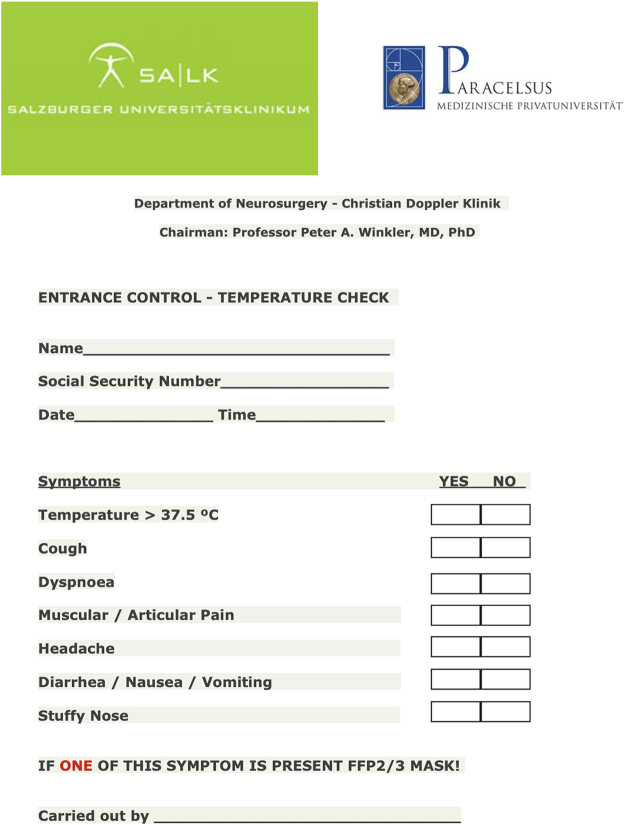To the Editor:
We appreciated the Letter, “Letter: Neurosurgery and Coronavirus (COVID-19) Epidemic: Doing Our Part” by Pesce et al,1 published in April 2020 in Neurosurgery.
We are grateful to the authors of the Letter for their clear analysis of some neurosurgical procedures in the COVID-19 era. Everyone in the neurosurgical community and in the whole medical community is doing their own part to face this terrible pandemic. Specifically, we would like to present our experience with patients needing a lumbar function or a neuroimaging. We already described our strategy for all emergency patients in an article published in Neurosurgery in April 2020 entitled “In Reply: Rongeurs, Neurosurgeons, and COVID-19: How Do We Protect Health Care Personnel During Neurosurgical Operations in the Midst of Aerosol-Generation From High-Speed Drills?”2
Different is our approach to the patients coming with an appointment for hospitalization. All patients should come to the Emergency in order to be evaluated through our questionnaire (Figure) and temperature check, and to be tested with the nasopharyngeal tampon for COVID-19. In the meantime, the patient is hospitalized in the ward, in an isolated room. The patient wears a mask and they are forbidden to remove the mask until the result of the swab arrives (usually 4-6 h). A trained nurse will perform an additional temperature check and a preoperative blood sample. A doctor will collect the anamnesis and visit the patient, deciding which further preoperative examinations he will have to perform. These nurses and doctors will not be in contact with other patients or medical and paramedical people. Every preoperative or further diagnostic, including lumbar puncture and/or neuroimaging, will be performed after the result (negative) of the test. In case the patient needs a lumbar puncture, first, we checked the blood tests and did a craniocervical computed tomography (CT) scan in order to exclude all possible absolute contraindications for a lumbar puncture. The CT bed is covered with sterile plastic protection, which will be removed and a complete disinfection performed after the procedure.
FIGURE.
Emergency questionnaire. Logos used with permission. © PMU and © SALK. All rights reserved.
Therefore, the doctor and the nurse who had contact with the patient will perform the lumbar puncture in the same room, with sterile equipment and all full-protection measures, as for a COVID-19-positive patient. If the patient has a positive result for COVID-19, they will be transferred to the “Covid-House,” an isolated department only for COVID-19-positive patients. In this case, all the medical and paramedical staff who were in contact with the patient should go to quarantine for 14 d.2 In the case of a negative result, the patient will be moved to a normal room for completing all further planned diagnostic and/or therapeutic procedures.
Using this scheme, so far, our neurosurgical department has been COVID-19 free and we have already started to perform all the required diagnostic procedures, invasive (e.g. digital subtraction angiography, lumbar puncture, myelography, etc) and noninvasive (all neuroimaging diagnostics), and all the elective surgical operations. We are very glad to be able to share our experience with the rest of the neurosurgery community, and we are sure that all together we can certainly improve our neurosurgical performances in a safe way for us and for the patients.
Funding
This study did not receive any funding or financial support.
Disclosures
The authors have no personal, financial, or institutional interest in any of the drugs, materials, or devices described in this article.
Contributor Information
S Ottavio Tomasi, Department of Neurological Surgery Christian Doppler Klinik Paracelsus Medical University Salzburg, Austria; Laboratory for Microsurgical Neuroanatomy Christian Doppler Klinik Salzburg, Austria.
Giuseppe Emmanuele Umana, Department of Neurosurgery Cannizzaro Hospital Trauma Center Gamma Knife Center Catania, Italy.
Giuseppe Raudino, Department of Neurosurgery Istituto di Ricovero e Cura ad alta specializzazione Policlinico di Monza Monza, Italy.
Gianluca Scalia, Neurosurgery Unit Highly Specialized Hospital and of National Importance “Garibaldi” Catania, Italy.
Mario Ganau, Division of Neurosciences Oxford University Hospitals NHS Foundation Trust Oxford, United Kingdom.
Peter A Winkler, Department of Neurological Surgery Christian Doppler Klinik Paracelsus Medical University Salzburg, Austria; Laboratory for Microsurgical Neuroanatomy Christian Doppler Klinik Salzburg, Austria.
REFERENCES
- 1. Pesce A, Palmieri M, Armocida D, Frati A, Santoro A. Letter: neurosurgery and coronavirus (COVID-19) epidemic: doing our part. Neurosurgery. published online: 2020; (doi: 10.1093/neuros/nyaa115). [DOI] [PMC free article] [PubMed] [Google Scholar]
- 2. Tomasi SO, Umana GE, Scalia G, Winkler PA. In reply: rongeurs, neurosurgeons, and COVID-19: how do we protect health care personnel during neurosurgical operations in the midst of aerosol-generation from high-speed drills?. Neurosurgery. published online: 2020; (doi: 10.1093/neuros/nyaa113). [DOI] [PMC free article] [PubMed] [Google Scholar]



